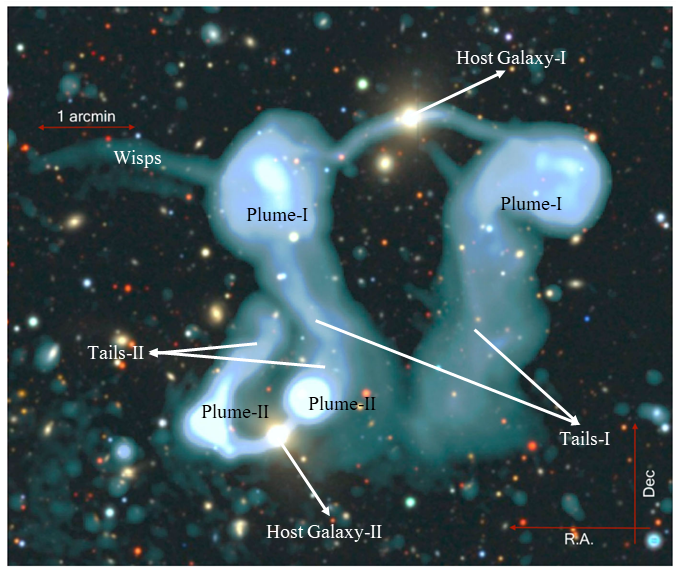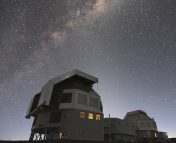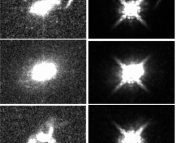Title: MeerKAT view of the Dancing Ghosts — Peculiar Galaxy Pair PKS 2130-538 in Abell 3785
Authors: Velibor Velović, William D. Cotton, Miroslav D Filipović, Ray P. Norris, Luke A. Barnes, and James J. Condon
First Author’s Institution: School of Science, Western Sydney University, Locked Bag 1797, Penrith South DC, NSW 2751, Australia
Status: Published in MNRAS [open access]

by Gourab Giri
Gourab Giri is a Prime Minister’s Research Fellow in India, working on a PhD focused on bent jetted systems and their impact on the surrounding environment. His broader interests encompass galaxy evolution, including topics such as the process of galaxy collisions and the feedback of jets on galaxies. He is currently affiliated with the Indian Institute of Technology Indore, India.
The majority of galaxies likely host supermassive black holes (SMBHs) at their centres. These SMBHs can become highly active, but it is not yet fully understood why. In these active phases, SMBHs consume surrounding gas at an accelerated rate through an accretion disk. During this phase, the central SMBH release a lot of energy by magnetically grabbing bits of this accreting material from the disk and then shooting these bits out along the black hole’s spin axis at velocities approaching the speed of light. The material then moves in a straight-line trajectory that often spans several tens of millions of light years. This super-heated matter thrown by the central SMBH also carries part of the magnetic field with it, causing the matter constituents to start spiralling around the field lines and emit electromagnetic radiation, mostly in the radio wavelength (synchrotron radiation). When observed with radio telescopes, they appear as a fountain-like jetted structure in a galaxy, which is then referred to as an “extended radio galaxy”. These events, which are some of the most energetic and violent phenomena in the universe, show properties that are not fully understood. Today’s paper investigates what the origin of a complex radio structure of “dancing ghosts” can reveal about these jets.
While observed with modern highly sensitive and high-resolution radio telescopes, a minority of jetted galaxies exhibit noticeable deviations in the trajectory of the ejected matter, namely, a departure from their expected straight-line trajectories. Some of these galaxies show jets that bend in a consistent direction away from their host galaxy, forming a tail-like structure. We identify these peculiar radio-frequency morphologies as “head-tail” sources (Fig. 1). The “head” represents the galaxy that hosts a supermassive black hole ejecting jets along a straight-line direction. However, if the host galaxy moves translationally along a path, which typically occurs in galaxy clusters where individual galaxies interact gravitationally, the ejected jets of matter bend in the same direction, creating the tail-like structure observed in radio frequencies (see Fig. 1). The “plume” structure in the jet in Fig. 1 forms when the jet’s propagation speed decreases due to its interaction with the surrounding medium. This medium is typically the plasma gas located between galaxies in a galaxy cluster.

Figure 2 shows a complex version of this scenario in which two head-tail sources are situated close to each other. The overall morphology resembles “dancing ghosts” floating in the cosmos, a name given to them by the authors of the article. The object, formally called PKS 2130-538, is shown as observed by the MeerKAT radio telescope in South Africa. This image is overlapped with an optical map from the Dark Energy Survey (DES) in order to identify the host galaxies of the bent jets.

The initial question upon viewing this image is whether the two jetted features are interacting or if the resultant structure is merely a projection effect with both individual head-tail sources coincidentally aligning in the same viewing direction. Answering this question isn’t straightforward. The authors delved deep into the data, conducting complex tests to arrive at an answer. Their first step involved examining the spectral index (also denoted by α) distribution, a proxy for understanding the locations of both freshly injected, energetic particles and older, cooling particles. The spectral-map in their paper confirmed that these individual radio galaxies with given morphologies indeed match the distribution of general head-tail sources, in which older, cooling particles accumulate in the tails, while the heads are filled with fresh plasma. It is anticipated that when the jets of two galaxies interact, the particles at the point of interaction will be energized. Consequently, the behavior of the spectral map is expected to reveal such an energizing phenomenon. However, no such signature is observed. The authors then used an edge-detection technique (a technique to identify prominent emission zones within a rather broader diffuse emission region) to uncover the inner filamentary structures by efficiently removing the diffuse emissions. This approach aimed to determine whether the filamentary structures of the given radio morphology exhibited complex, vortex-like shapes at the interaction point of the jet feature (in case they have interacted). However, in the authors’ analysis, such structures were not found. Instead, the filaments remained parallel to the jet flow direction. Therefore, it became evident that these were likely head-tail galaxies appearing close due to a fortuitous viewing angle (projection effect) rather than actually being close enough to interact.
There is another aspect of the radio structure, intriguing “wisp” structures, which still sparks intense debate. Confusion arises from questions about whether these extended, substantial outflows from the jet axis result from complex magnetic field distribution or if they stem from matter leakage due to instabilities encountered by the fast-moving jet as it travels through the surrounding medium. The current method of analysis may not be adequate to definitively pinpoint the origin of these wisps, calling for further investigation.
Featured image credit: Figure 1 of the paper, with modifications
Astrobite edited by Emma Clarke





Left plume in photo reminds me of a Klein bottle
La Astrofísica contenida en el chorro relativista de un Cuásar, es completamente IGUAL a la del chorro de una fuente de agua, según he deducido hace décadas.-
Saludos